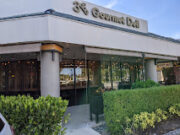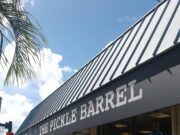
Deerfield-News.com-Deerfield Beach, Fl- Tonight is the beginning of Rosh Hashanah the Jewish new year. All three Deerfield Beach synagogues should be bustling with people getting ready to pray and welcome in the new year. The Jewish calendar this evening will turn to the year 5780.
From Wikipedia.com-
Rosh Hashanah (Hebrew: רֹאשׁ הַשָּׁנָה), literally meaning the “head [of] the year”, is the Jewish New Year. The biblical name for this holiday is Yom Teruah (יוֹם תְּרוּעָה), literally “day of shouting or blasting”. It is the first of the Jewish High Holy Days (יָמִים נוֹרָאִים Yamim Nora’im. “Days of Awe”) specified by Leviticus 23:23–32 that occur in the early autumn of the Northern Hemisphere.
| Rosh Hashanah | |
|---|---|

A shofar, symbol of the Rosh Hashanah holiday
|
|
| Official name | ראש השנה |
| Also called | Jewish New Year |
| Observed by | Jews |
| Type | Jewish |
| Observances | Praying in synagogue, personal reflection, and hearing the shofar. |
| Begins | Start of first day of Tishrei |
| Ends | End of second day of Tishrei |
| Date | 1 Tishrei |
| 2019 date | Sunset, 29 September – nightfall, 1 October[1] |
| 2020 date | Sunset, 18 September – nightfall, 20 September[1] |
| 2021 date | Sunset, 6 September – nightfall, 8 September[1] |
Rosh Hashanah is a two-day celebration that begins on the first day of Tishrei, which is the seventh month of the ecclesiastical year. In contrast to the ecclesiastical year, where the first month Nisan, the Passover month, marks Israel’s exodus from Egypt, Rosh Hashanah marks the beginning of the civil year, according to the teachings of Judaism, and is the traditional anniversary of the creation of Adam and Eve, the first man and woman according to the Hebrew Bible, and the inauguration of humanity’s role in God’s world. According to one secular opinion, the holiday owes its timing to the beginning of the economic year in Southwest Asia and Northeast Africa, marking the start of the agricultural cycle.[2]
Rosh Hashanah customs include sounding the shofar (a cleaned-out ram’s horn), as prescribed in the Torah, following the prescription of the Hebrew Bible to “raise a noise” on Yom Teruah. Its rabbinical customs include attending synagogue services and reciting special liturgy about teshuva, as well as enjoying festive meals. Eating symbolic foods is now a tradition, such as apples dipped in honey, hoping to evoke a sweet new year.
Contents
EtymologyEdit
“Rosh” is the Hebrew word for “head”, “ha” is the definite article (“the”), and “shanah” means year. Thus “Rosh HaShanah” means ‘head [of] the year’, referring to the Jewish day of new year.[3][4]
The term “Rosh Hashanah” in its current meaning does not appear in the Torah. Leviticus 23:24 refers to the festival of the first day of the seventh month as “Zikhron Teru’ah” (“[a] memorial [with the] blowing [of horns]”); it is also referred to in the same part of Leviticus as ‘שַׁבַּת שַׁבָּתוֹן‘ (shabbat shabbaton) or ultimate Sabbath or meditative rest day, and a “holy day to God”. These same words are commonly used in the Psalms to refer to the anointed days. Numbers 29:1 calls the festival Yom Teru’ah, (“Day [of] blowing [the horn]”), and symbolizes several subjects, such as the Binding of Isaac whereby a ram was sacrificed instead of Isaac, and the animal sacrifices, including rams, that were to be performed.[5][6] (The term Rosh Hashanah appears once in the Bible in Ezekiel 40:1 where it means generally the time of the “beginning of the year” or is possibly a reference to Yom Kippur,[5] but the phrase may also refer to the Hebrew month of Nisan in the spring, especially in light of Exodus 12:2, Exodus 13:3–4 where the spring month of Aviv, later renamed Nisan, is stated as being “the first month of the year” and Ezekiel 45:18 where “the first month” unambiguously refers to Nisan,[7][8] the month of Passover, as made plain by Ezekiel 45:21.[9])
In the Jewish prayer-books (i.e. the Siddur and Machzor), Rosh Hashanah is also called “Yom Hazikaron” ([a] day [of] the remembrance),[4] not to be confused with the modern Israeli holiday of the same name, which falls in spring.[citation needed]
The Hebrew Rosh HaShanah is etymologically related to the Arabic Ras as-Sanah, the name Muslims give for the Islamic New Year.[citation needed]
Rosh Hashanah marks the start of a new year in the Hebrew calendar (one of four “new year” observances that define various legal “years” for different purposes as explained in the Mishnah and Talmud).[4] It is the new year for people, animals, and legal contracts. The Mishnah also sets this day aside as the new year for calculating calendar years, shmita and yovel years. Rosh Hashanah commemorates the creation of man.[10]
OriginEdit
The origin of the Hebrew New Year is connected to the beginning of the economic year in the agricultural societies of the ancient Near East.[2] The New Year was the beginning of the cycle of sowing, growth, and harvest; the harvest was marked by its own set of major agricultural festivals.[2] The Semites generally set the beginning of the new year in autumn, while other ancient civilizations chose spring for that purpose, such as the Persians or Greeks; the primary reason was agricultural in both cases, the time of sowing the seed and bringing in the harvest.[2]
In Jewish law, four major New Years are observed, each one marking a beginning of sorts. The lunar month Nisan (usually corresponding to the months March–April in the Gregorian calendar) is when a new year is added to the reign of Jewish kings, and it marks the start of the year for the three Jewish pilgrimages.[11] Its injunction is expressly stated in the Hebrew Bible: “This month shall be unto you the beginning of months” (Exo. 12:2). However, ordinary years, Sabbatical years, Jubilees, and dates inscribed on legal deeds and contracts are reckoned differently; such years begin on the first day of the lunar month Tishri (usually corresponding to the months September–October in the Gregorian calendar). Their injunction is expressly stated in the Hebrew Bible: “Three times in the year you shall keep a feast unto me… the feast of unleavened bread (Passover)… the feast of harvest (Shavuot)… and the feast of ingathering (Sukkot) which is at the departing of the year” (Exo. 23:14–16). “At the departing of the year” implies that the new year begins here.[12]
The reckoning of Tishri as the beginning of the Jewish year began with the early Egyptians and was preserved by the Hebrew nation,[13] being also alluded to in the Hebrew Bible (Genesis 7:11) when describing the Great Deluge at the time of Noah. This began during the “second month” (Marheshvan) counting from Tishri, a view that has largely been accepted by the Sages of Israel.[14]
Religious significanceEdit
The Mishnah contains the second known reference to Rosh Hashanah as the “day of judgment”.[15] In the Talmud tractate on Rosh Hashanah, it states that three books of account are opened on Rosh Hashanah, wherein the fate of the wicked, the righteous, and those of the intermediate class are recorded. The names of the righteous are immediately inscribed in the book of life and they are sealed “to live”. The intermediate class is allowed a respite of ten days, until Yom Kippur, to reflect, repent and become righteous;[16] the wicked are “blotted out of the book of the living forever”.[17]
In Jewish liturgy, Rosh Hashanah leads to Yom Kippur, which is described as “the day of judgment” (Yom ha-Din) and “the day of remembrance” (Yom ha-Zikkaron). Some midrashic descriptions depict God as sitting upon a throne, while books containing the deeds of all humanity are opened for review, and each person passes in front of Him for evaluation of his or her deeds. The Talmud provides three central ideas behind the day:
“The Holy One said, ‘on Rosh Hashanah recite before Me [verses of] Sovereignty, Remembrance, and Shofar blasts (malchiyot, zichronot, shofrot): Sovereignty so that you should make Me your King; Remembrance so that your remembrance should rise up before Me. And through what? Through the Shofar.’ (Rosh Hashanah 16a, 34b)”[18] This is reflected in the prayers composed by the classical rabbinic sages for Rosh Hashanah found in all machzorim where the theme of the prayers is the strongest theme is the “coronation” of God as King of the universe in preparation for the acceptance of judgments that will follow on that day, symbolized as “written” into a Divine book of judgments, that then hang in the balance for ten days waiting for all to repent, then they will be “sealed” on Yom Kippur. The assumption is that everyone was sealed for life and therefore the next festival is Sukkot (Tabernacles) that is referred to as “the time of our joy” (z’man simchateinu).
CustomsEdit
The Yamim Nora’im are preceded by the month of Elul, during which Jews are supposed to begin a self-examination and repentance, a process that culminates in the ten days of the Yamim Nora’im known as beginning with Rosh Hashanah and ending with the holiday of Yom Kippur.[citation needed]
The shofar is traditionally blown each morning for the entire month of Elul, the month preceding Rosh Hashanah. The sound of the shofar is intended to awaken the listeners from their “slumbers” and alert them to the coming judgment.[19] The shofar is not blown on Shabbat.[20]
In the period leading up to the Yamim Nora’im (Hebrew, “days of awe”), penitential prayers, called selichot, are recited.[citation needed]
Rosh Hashanah is also the day of “Yom Hadin”, known as Judgment day. On Yom Hadin, three books are opened, the book of life, for the righteous among the nations, the book of death, for the most evil who receive the seal of death, and the third book for the ones living in doubts with non-evil sins.[citation needed]
Karaite JudaismEdit
Unlike the denominations of Rabbinical Judaism, Karaite Judaism believes the Jewish New Year starts with the first month and celebrate this holiday only as it is mentioned in the Torah, that is as a day of rejoicing and shouting.[21] Additionally, Karaites believe the adoption of “Rosh Hashanah” in place of Yom Teruah “is the result of pagan Babylonian influence upon the Jewish nation,[21] that began during the Babylonian exile with the adoption of the Babylonian month names instead of the numbering present in the Torah (Leviticus 23; Numbers 28).[21] Karaites allow no work on the day except what is needed to prepare food (Leviticus 23:23, 24).[22]
SamaritanismEdit
Samaritans, in their interpretation of the Torah, preserve the biblical name of the festival celebrated on the first day of the seventh month (Tishrei), namely Yom Teruah, and do not consider it to be a New Year‘s day.[23]
Shofar blowingEdit
Laws on the form and use of the shofar and laws related to the religious services during the festival of Rosh Hashanah are described in Rabbinic literature such as the Mishnah that formed the basis of the tractate “Rosh HaShanah” in both the Babylonian Talmud and the Jerusalem Talmud. This also contains the most important rules concerning the calendar year.[24]
The shofar is blown in specific long, short, and staccato blasts:
- Teki’ah (one long sound)
- Shevarim (three broken sounds)
- Shevarim Teru’ah (three broken sounds followed by nine short sounds).
- Teru’ah (nine short sounds)
- Teki’ah Gedolah (a very long sound)[25]
The shofar is blown at various instances during the Rosh Hashanah prayers, with a total of 100 blasts over the day.[26]
Rosh Hashanah eveEdit
The day before Rosh Hashanah day is known as Erev Rosh Hashanah (“Rosh Hashanah eve”).[27] It is the 29th day of the Hebrew month of Elul, ending at sundown, when Rosh Hashanah commences. Some communities perform Hatarat nedarim (a nullification of vows) after the morning prayer services.[28] The mood becomes festive but serious in anticipation of the new year and the synagogue services.[citation needed] Many Orthodox men immerse in a mikveh in honor of the coming day.[29]
Duration and timingEdit
Rosh Hashanah occurs 163 days after the first day of Passover (Pesach). In terms of the Gregorian calendar, the earliest date on which Rosh Hashanah can fall is September 5, as happened in 1842, 1861, 1899 and 2013. The latest Gregorian date that Rosh Hashanah can occur is October 5, as happened in 1815, 1929 and 1967, and will happen again in 2043. After 2089, the differences between the Hebrew calendar and the Gregorian calendar will result in Rosh Hashanah falling no earlier than September 6. Starting in 2214, the new latest date will be October 6.[30]
Although the Jewish calendar is based on the lunar cycle, so that the first day of each month originally began with the first sighting of a new moon, since the fourth century it has been arranged so that Rosh Hashanah never falls on a Sunday, Wednesday, or Friday.[31][31]
The Torah defines Rosh Hashanah as a one-day celebration, and since days in the Hebrew calendar begin at sundown, the beginning of Rosh Hashanah is at sundown at the end of 29 Elul. The rules of the Hebrew calendar are designed such that the first day of Rosh Hashanah will never occur on the first, fourth, or sixth day of the Jewish week[32] (i.e., Sunday, Wednesday, or Friday). Since the time of the destruction of the Second Temple of Jerusalem in 70 CE and the time of Rabban Yohanan ben Zakkai, normative Jewish law appears to be that Rosh Hashanah is to be celebrated for two days, because of the difficulty of determining the date of the new moon.[5] Nonetheless, there is some evidence that Rosh Hashanah was celebrated on a single day in Israel as late as the thirteenth century CE.[33] Orthodox and Conservative Judaism now generally observe Rosh Hashanah for the first two days of Tishrei, even in Israel where all other Jewish holidays dated from the new moon last only one day. The two days of Rosh Hashanah are said to constitute “Yoma Arichtah” (Aramaic: “one long day”). In Reform Judaism, while most congregations in North America observe only the first day of Rosh Hashanah, some follow the traditional two-day observance as a sign of solidarity with other Jews worldwide.[34] Karaite Jews, who do not recognize Rabbinic Jewish oral law and rely on their own understanding of the Torah, observe only one day on the first of Tishrei, since the second day is not mentioned in the Written Torah.[citation needed]
Prayer serviceEdit
| Learn more |
On Rosh Hashanah day, religious poems, called piyyutim, are added to the regular services. A special prayer book, the mahzor, is used on Rosh Hashanah and Yom Kippur (plural mahzorim). A number of additions are made to the regular service, most notably an extended repetition of the Amidah prayer for both Shacharit and Mussaf. The Shofar is blown during Mussaf at several intervals. (In many synagogues, even little children come and hear the Shofar being blown.) Biblical verses are recited at each point. According to the Mishnah, 10 verses (each) are said regarding kingship, remembrance, and the shofar itself, each accompanied by the blowing of the shofar. A variety of piyyutim, medieval penitential prayers, are recited regarding themes of repentance. The Alenu prayer is recited during the repetition of the Mussaf Amidah.
The Mussaf Amidah prayer on Rosh Hashanah is unique in that apart from the first and last 3 blessings, it contains 3 central blessings making a total of 9. These blessings are entitled “Malchuyot” (Kingship, and also includes the blessing for the holiness of the day as is in a normal Mussaf), “Zichronot” (Remembrance) and “Shofarot” (concerning the Shofar). Each section contains an introductory paragraph followed by selections of verses about the “topic”. The verses are 3 from the Torah, 3 from the Ketuvim, 3 from the Nevi’im, and one more from the Torah. During the repetition of the Amidah, the Shofar is sounded (except on Shabbat) after the blessing that ends each section.




































